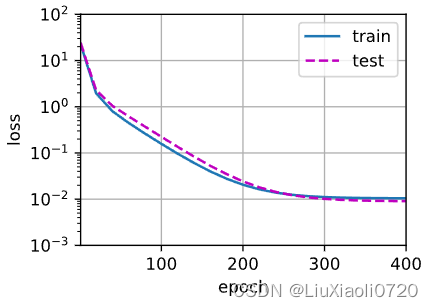import math
import numpy as np
import torch
from torch import nn
from d2l import torch as d2l
生成数据集
给定 x x x,我们将使用以下三阶多项式来生成训练和测试数据的标签:
y = 5 + 1.2 x − 3.4 x 2 2 ! + 5.6 x 3 3 ! + ϵ where ϵ ∼ N ( 0 , 0. 1 2 ) . y = 5 + 1.2x - 3.4\frac{x^2}{2!} + 5.6 \frac{x^3}{3!} + \epsilon \text{ where } \epsilon \sim \mathcal{N}(0, 0.1^2). y=5+1.2x−3.42!x2+5.63!x3+ϵ where ϵ∼N(0,0.12).
噪声项
ϵ
\epsilon
ϵ服从均值为0且标准差为0.1的正态分布。
在优化的过程中,我们通常希望避免非常大的梯度值或损失值。
这就是我们将特征从
x
i
x^i
xi调整为
x
i
i
!
\frac{x^i}{i!}
i!xi的原因,
这样可以避免很大的
i
i
i带来的特别大的指数值。
我们将为训练集和测试集各生成100个样本。
max_degree = 20 # 多项式的最大阶数
n_train, n_test = 100, 100 # 训练和测试数据集的大小
true_w = np.zeros(max_degree) # 分配大量空间
true_w[0:4] = np.array([5, 1.2, -3.4, 5.6])
features = np.random.normal(size = (n_train + n_test, 1))
np.random.shuffle(features)
poly_features = np.power(features, np.arange(max_degree).reshape(1, -1))
for i in range(max_degree):
poly_features[:, i] /= math.gamma(i + 1) # gamma(n)=(n-1)!
# labels的维度:(n_train + n_test)
labels = np.dot(poly_features, true_w)
labels += np.random.normal(scale = 0.1, size = labels.shape)
存储在poly_features中的单项式由gamma函数重新缩放,
其中
Γ
(
n
)
=
(
n
−
1
)
!
\Gamma(n)=(n-1)!
Γ(n)=(n−1)!。
从生成的数据集中查看一下前2个样本,
第一个值是与偏置相对应的常量特征。
# NumPy ndarray转换为tensor
true_w, features, poly_features, labels = [torch.tensor(x, dtype=
torch.float32) for x in [true_w, features, poly_features, labels]]
features[:2], poly_features[:2, :], labels[:2]
(tensor([[-1.2565],
[-2.2676]]),
tensor([[ 1.0000e+00, -1.2565e+00, 7.8936e-01, -3.3060e-01, 1.0385e-01,
-2.6096e-02, 5.4648e-03, -9.8091e-04, 1.5406e-04, -2.1508e-05,
2.7024e-06, -3.0868e-07, 3.2321e-08, -3.1238e-09, 2.8036e-10,
-2.3484e-11, 1.8442e-12, -1.3630e-13, 9.5145e-15, -6.2919e-16],
[ 1.0000e+00, -2.2676e+00, 2.5709e+00, -1.9433e+00, 1.1016e+00,
-4.9960e-01, 1.8881e-01, -6.1164e-02, 1.7337e-02, -4.3681e-03,
9.9049e-04, -2.0418e-04, 3.8583e-05, -6.7300e-06, 1.0901e-06,
-1.6479e-07, 2.3354e-08, -3.1151e-09, 3.9243e-10, -4.6835e-11]]),
tensor([ -1.1486, -17.5782]))
对模型进行训练和测试
首先实现一个函数来评估模型在给定数据集上的损失
def evaluate_loss(net, data_iter, loss): #@save
"""评估给定数据集上模型的损失"""
metric = d2l.Accumulator(2) # 损失的总和,样本数量
for X, y in data_iter:
out = net(X)
y = y.reshape(out.shape)
l = loss(out, y)
metric.add(l.sum(), l.numel())
return metric[0] / metric[1]
定义训练函数
def train(train_features, test_features, train_labels, test_labels,
num_epochs=400):
loss = nn.MSELoss()
input_shape = train_features.shape[-1]
# 不设置偏置,因为我们已经在多项式中实现了它
net = nn.Sequential(nn.Linear(input_shape, 1, bias=False))
batch_size = min(10, train_labels.shape[0])
train_iter = d2l.load_array((train_features, train_labels.reshape(-1,1)),
batch_size)
test_iter = d2l.load_array((test_features, test_labels.reshape(-1,1)),
batch_size, is_train=False)
trainer = torch.optim.SGD(net.parameters(), lr=0.01)
animator = d2l.Animator(xlabel='epoch', ylabel='loss', yscale='log',
xlim=[1, num_epochs], ylim=[1e-3, 1e2],
legend=['train', 'test'])
for epoch in range(num_epochs):
d2l.train_epoch_ch3(net, train_iter, loss, trainer)
if epoch == 0 or (epoch + 1) % 20 == 0:
animator.add(epoch + 1, (evaluate_loss(net, train_iter, loss),
evaluate_loss(net, test_iter, loss)))
print('weight:', net[0].weight.data.numpy())
三阶多项式函数拟合(正常)
首先使用三阶多项式函数,它与数据生成函数的阶数相同。
结果表明,该模型能有效降低训练损失和测试损失。
学习到的模型参数也接近真实值
w
=
[
5
,
1.2
,
−
3.4
,
5.6
]
w = [5, 1.2, -3.4, 5.6]
w=[5,1.2,−3.4,5.6]。
# 从多项式特征中选择前4个维度,即1,x,x^2/2!,x^3/3!
train(poly_features[:n_train, :4], poly_features[n_train:, :4],
labels[:n_train], labels[n_train:])
weight: [[ 5.016911 1.2140008 -3.4260864 5.581189 ]]
线性函数拟合(欠拟合)
当用于拟合非线性模式(如这里的三阶多项式函数)时,线性模型容易欠拟合。
# 从多项式特征中选择前2个维度,即1和x
train(poly_features[:n_train, :2], poly_features[n_train:, :2],
labels[:n_train], labels[n_train:])
weight: [[3.6582568 3.967709 ]]
高阶多项式函数拟合(过拟合)
尝试使用一个阶数过高的多项式来训练模型。在这种情况下,没有足够的数据用于学习高阶系数应该具有接近于零的值。因此,这个过于复杂的模型会轻易受到训练数据中噪声的影响。虽然训练损失可以有效地降低,但测试损失仍然很高。结果表明,复杂模型对数据造成了过拟合。
# 从多项式特征中选取所有维度
train(poly_features[:n_train, :], poly_features[n_train:, :],
labels[:n_train], labels[n_train:], num_epochs=1500)
weight: [[ 5.0074177 1.2689897 -3.3731365 5.1744385 -0.28380862 1.3880066
0.28433597 0.23886798 0.10456859 -0.01008706 -0.13444044 -0.00965116
-0.09757714 -0.09527045 0.21342376 0.13767722 -0.08204057 -0.10666441
0.12475184 0.21017507]]


